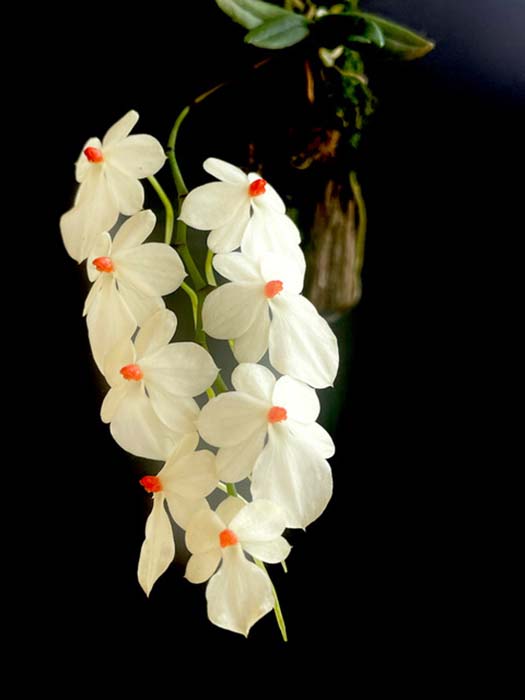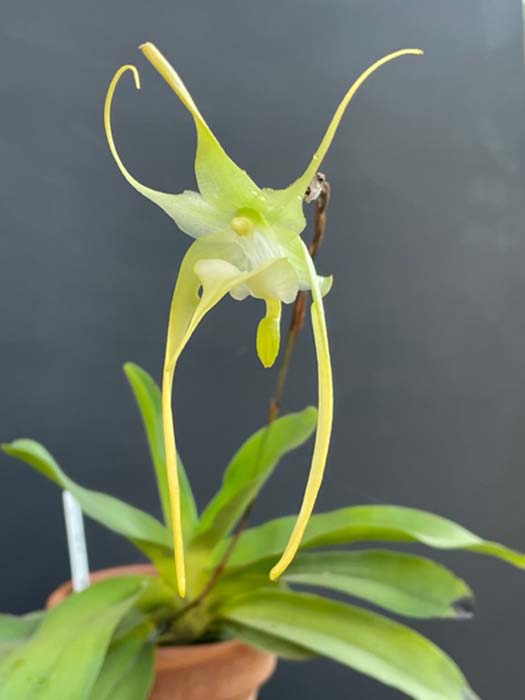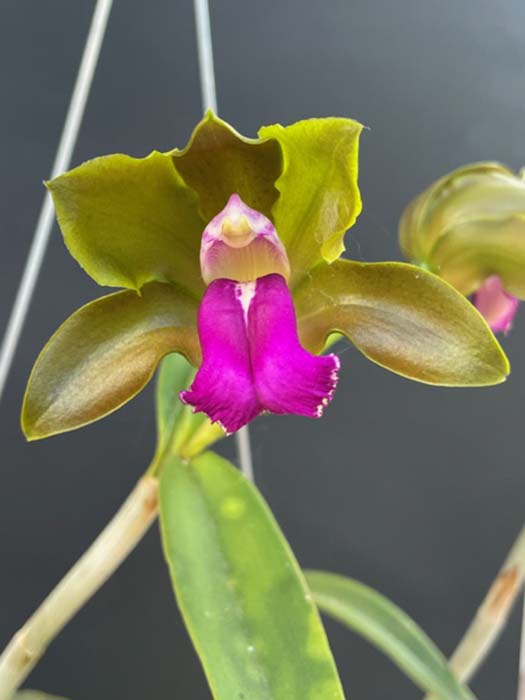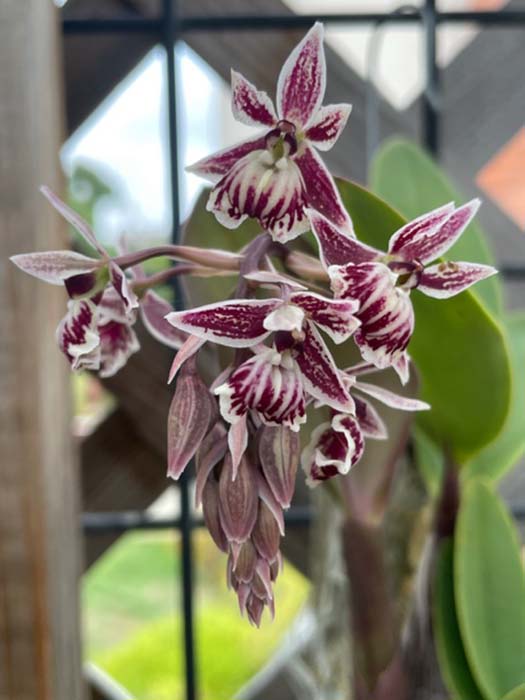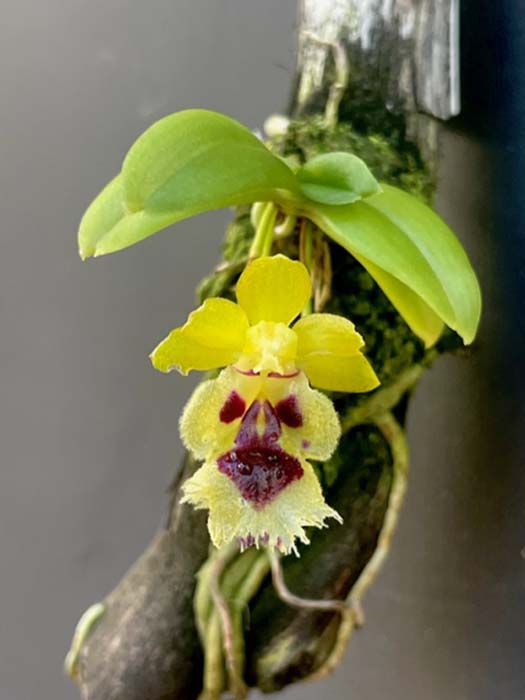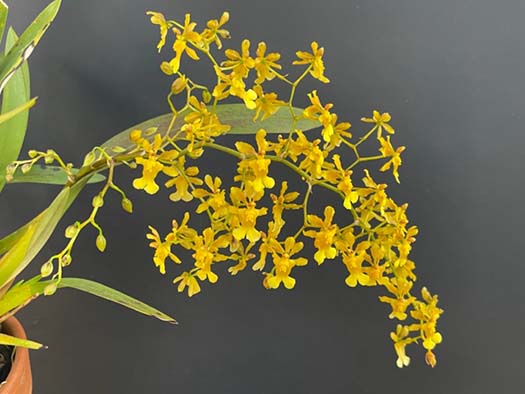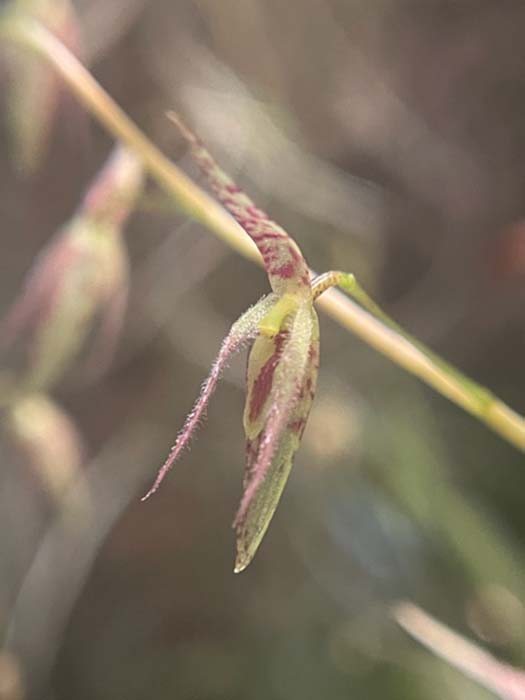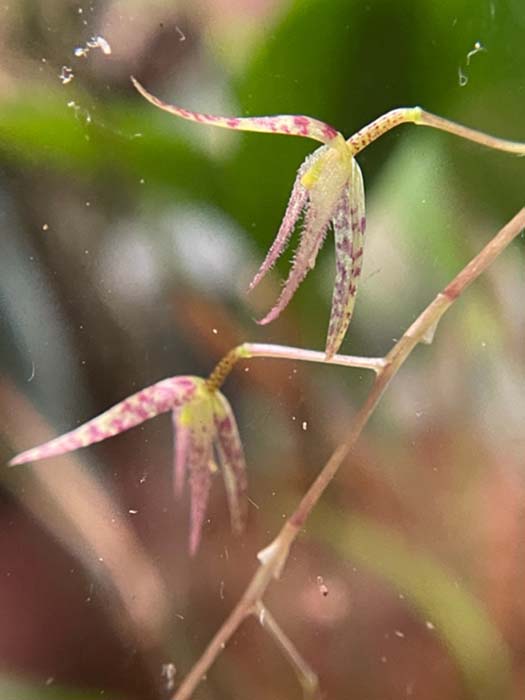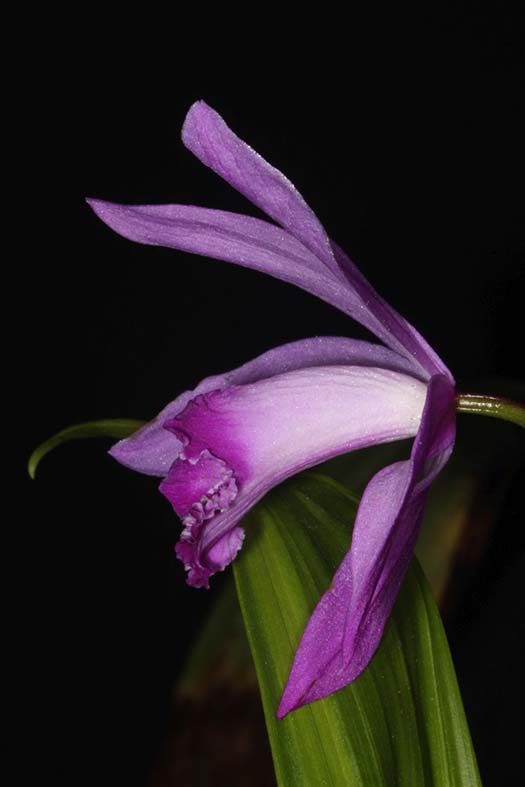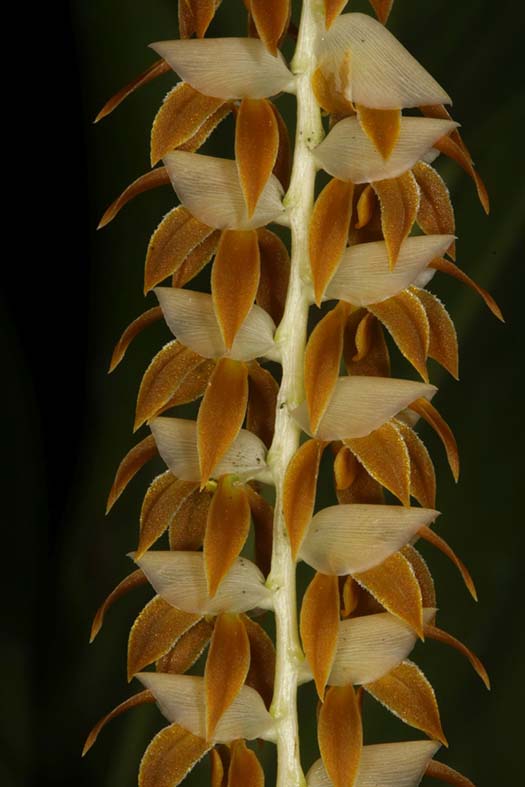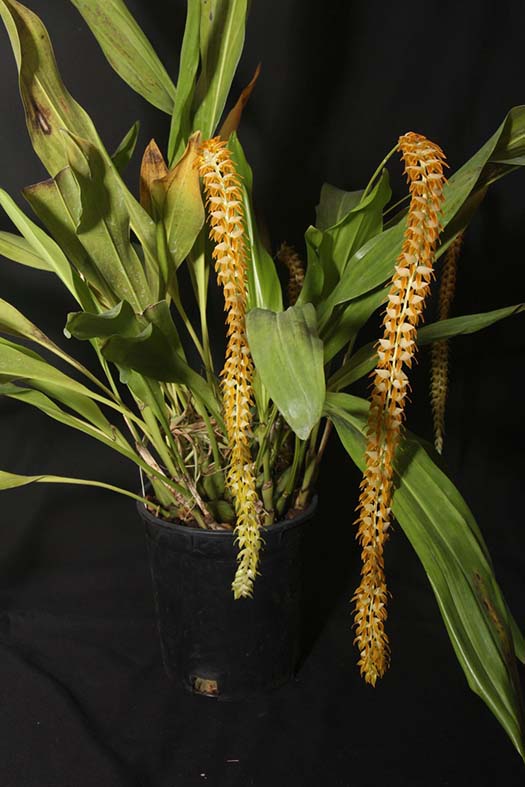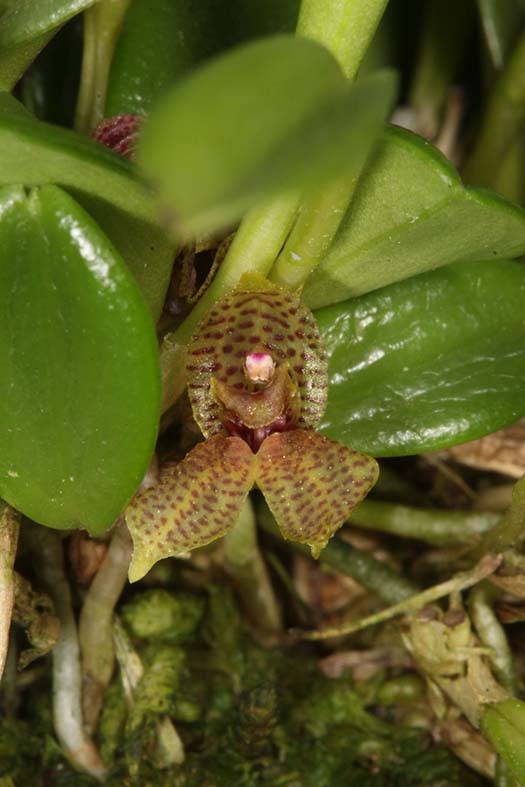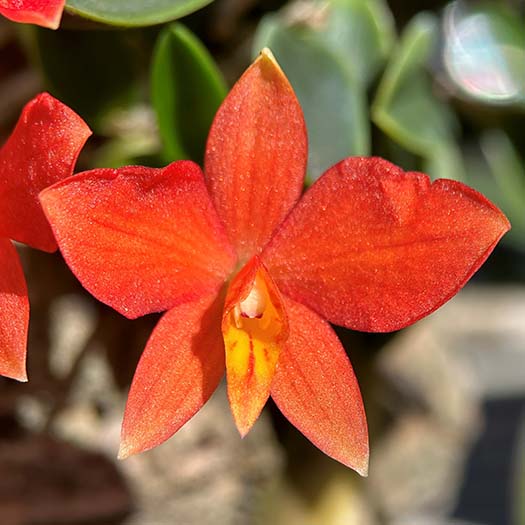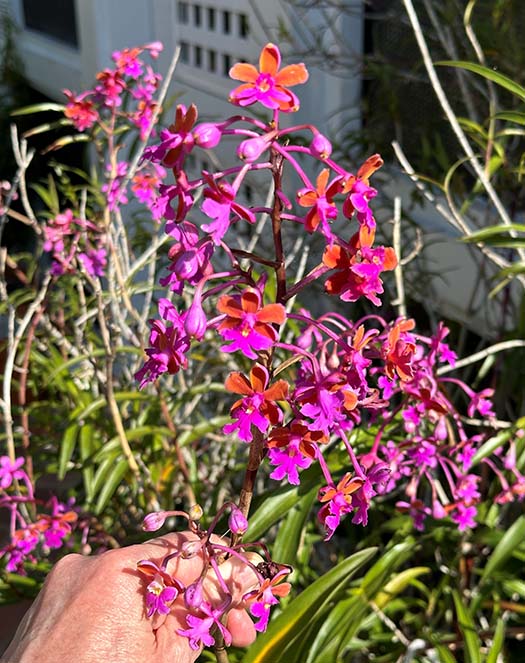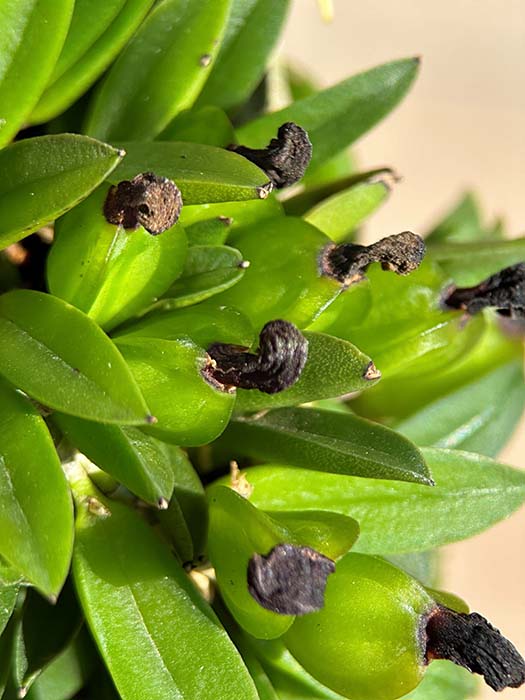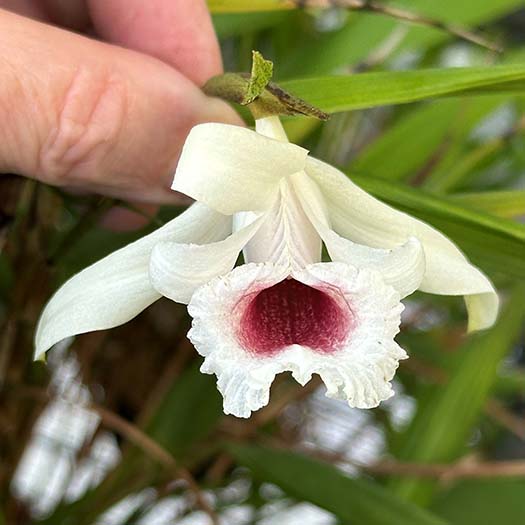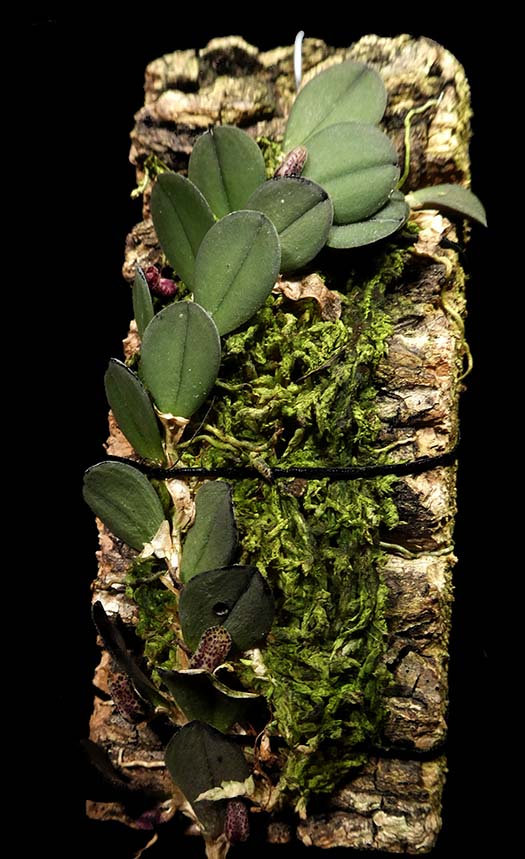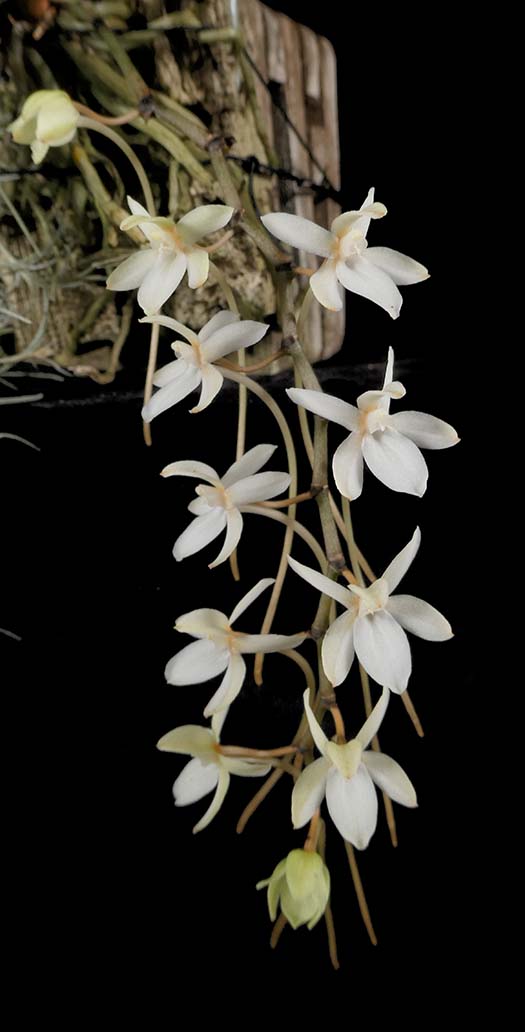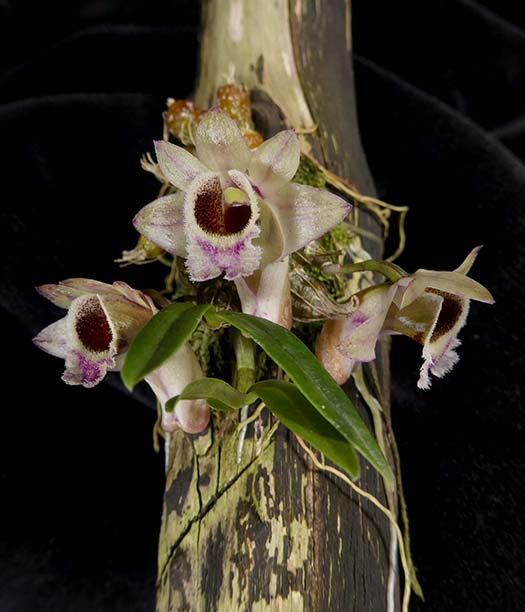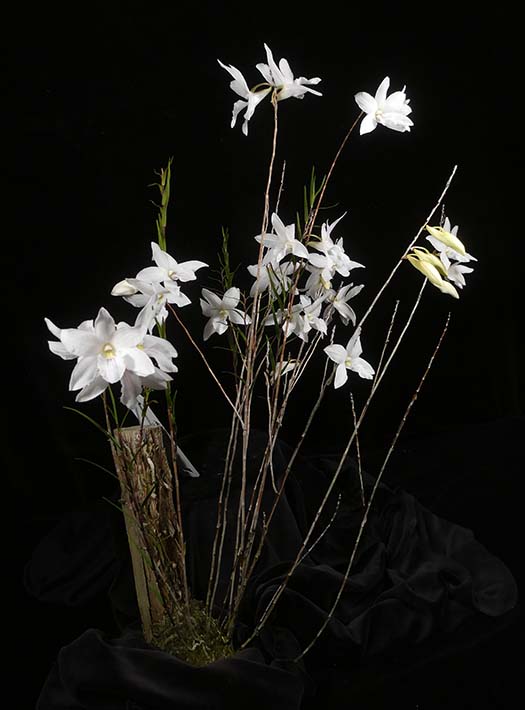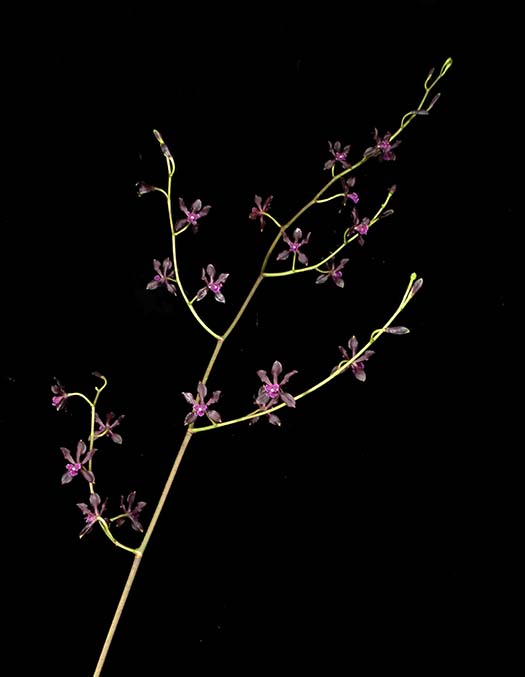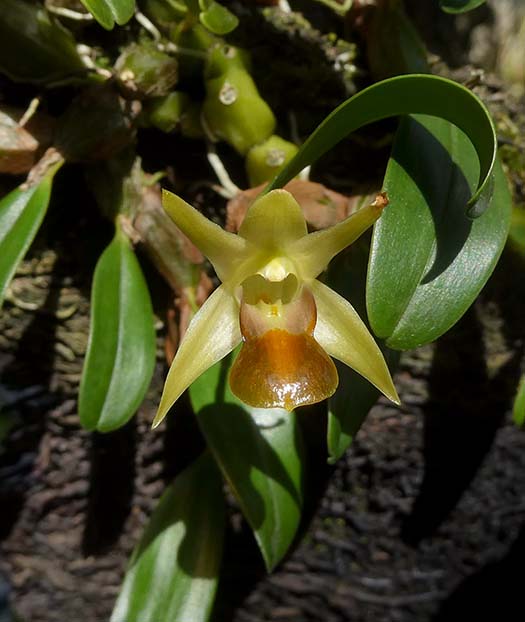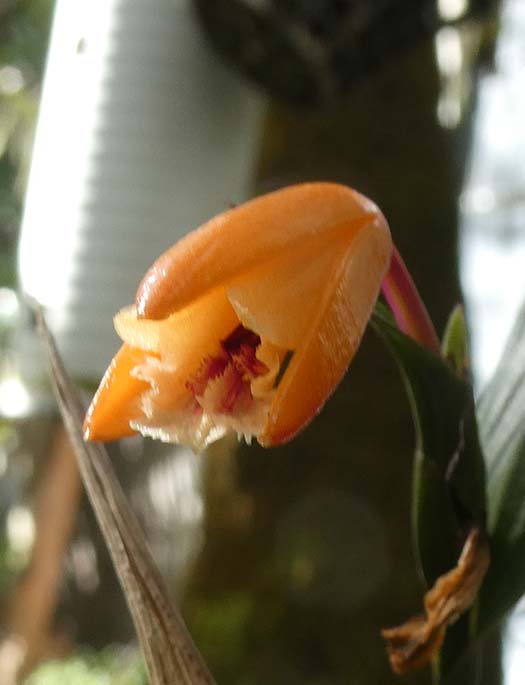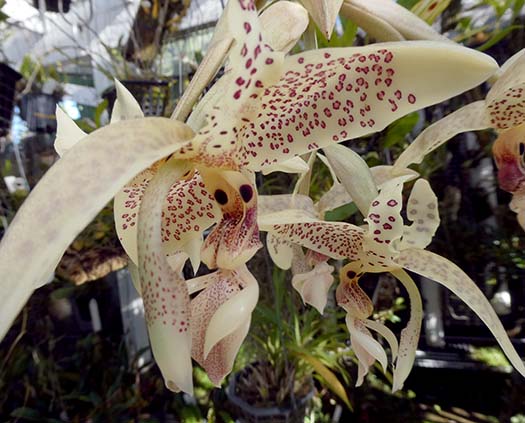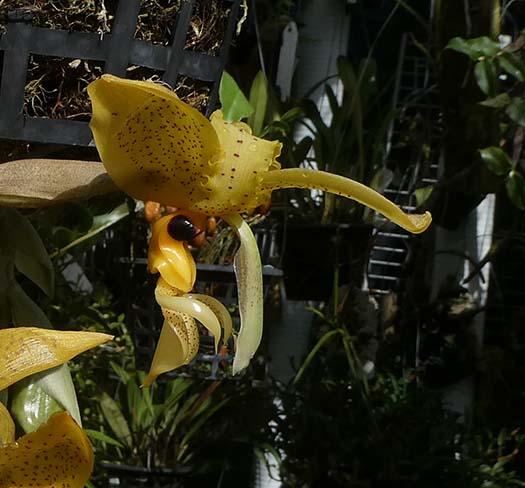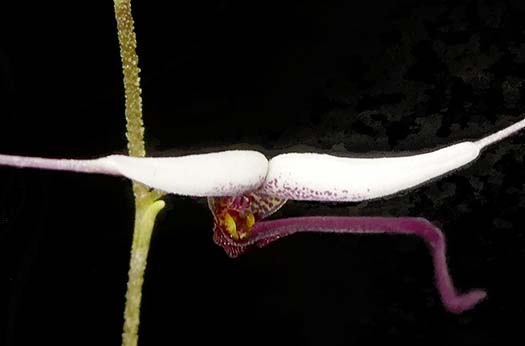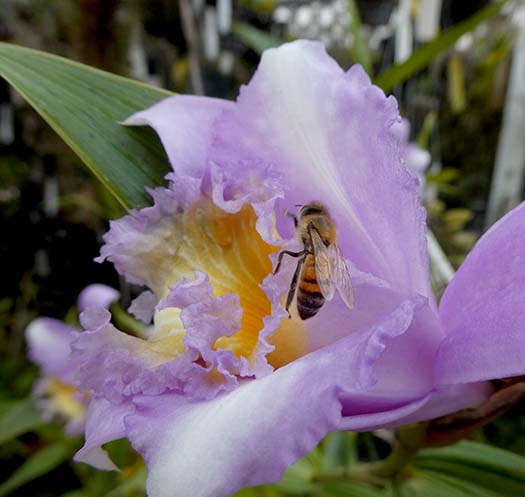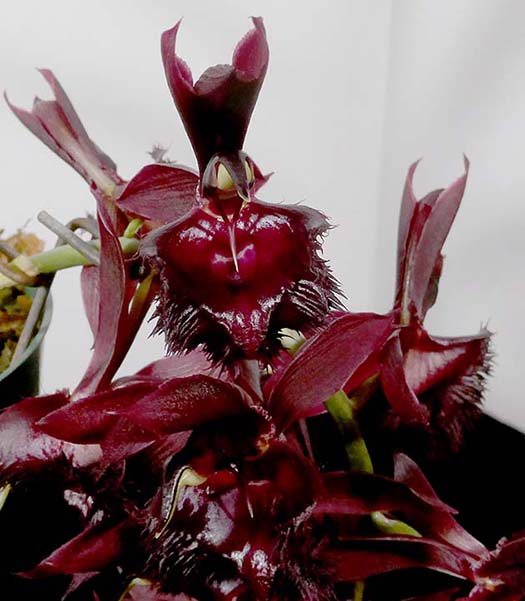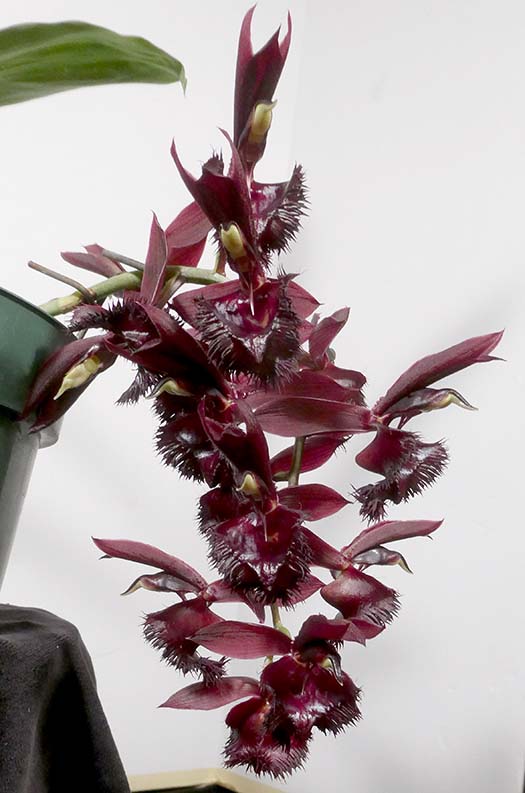November 2023
From Kurt Shanebeck:
|
|
Outdoors coastal, north of Los Angeles: |
|
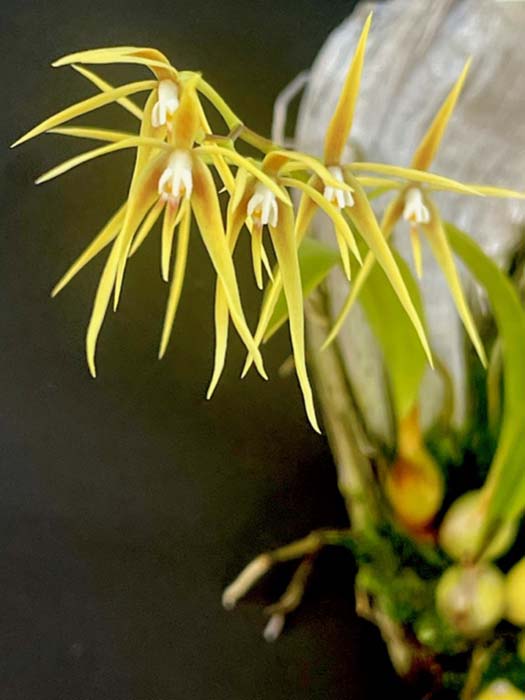
Prosthechea rhynchophoraCentral American epiphyte. Growing mounted with bright light. |
|

Vanda roeblingianaEpiphyte from Malaysia and Philippines at elevations above 1500m. Growing mounted and bright. |
|
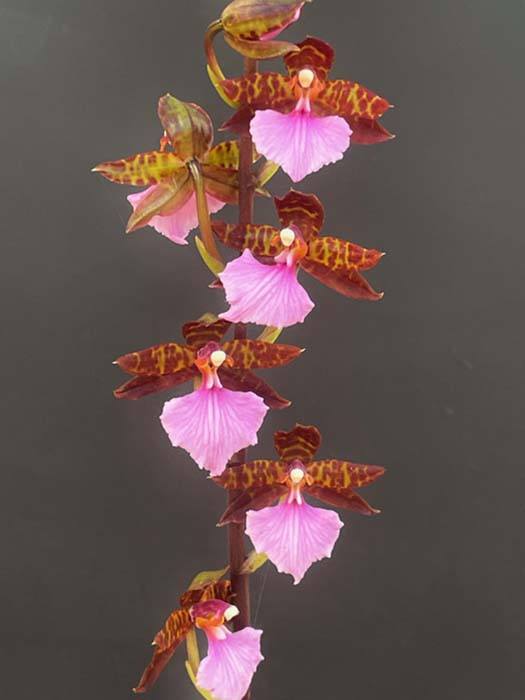
Rhynchostele bictoniensisAn epiphytic or terrestrial species from Mexico and Central America found at elevations of 2000-3200m. Growing potted with bright light. |
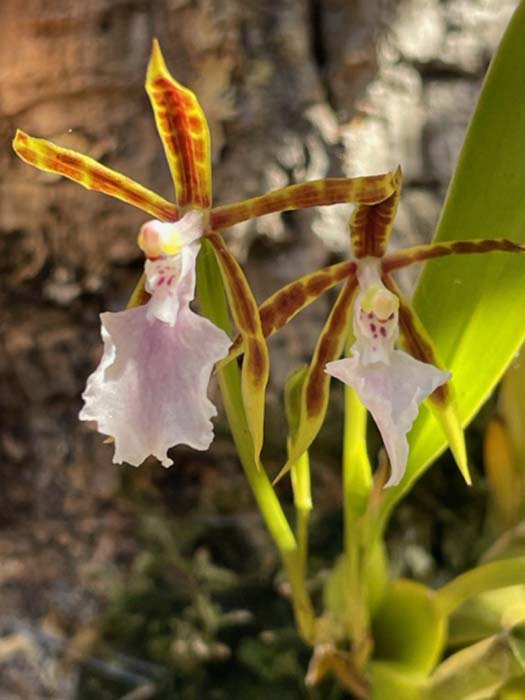
Rhynchostele stellataA epiphyte found in cloud forests from Mexico to Venezuela. Growing mounted and shady. |
Stelis flexuosissimaFound in Ecuador at elevations of 2100-3100m. Extremely small flowers hard to see without magnification. Growing mounted and shady.
|
|
Growing inside in a vivarium |
|
Pleurothallis fastidiosaFrom Ecuador and Peru |
|
From Chris Ehrler:
|
|
Coastal, California Central Coast |
|
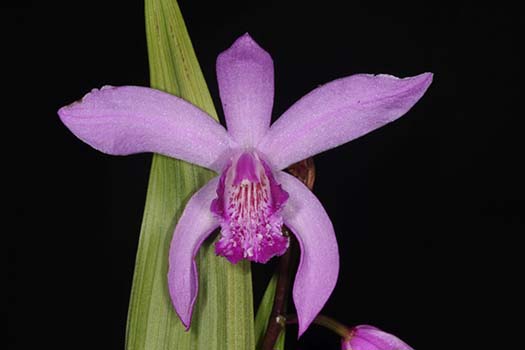 Bletilla striataA terrestrial cool to cold growing species found in Japan, Korea, China, Hong Kong, and Okinawa at elevations of 100 to 3200 meters. There are only four species in this genus. This orchid is growing in a plastic pot filled with planting mix. The pot is outside year-round in a shady location. |
|
Dendrochilum magnumNewly opened flowers above left, older flowers above right. A cool growing epiphyte natively growing in the Philippines at elevations of 1600 to 2000 meters. The petals are initially yellow but then turn orange as they age. This orchid is growing in a plastic pot filled with a mixture of bark and lava rock. The pot is in a cool greenhouse. |
|
Dryadella simulaA cold growing epiphyte found in Colombia, Ecuador and Peru in the lower cloud forests with a pronounced dry season in the summer and fall at 2000 to 3100 meters in elevation. The flowers grow out near the base of the leaves so you have to make sure you look for them to see them. The orchid is growing mounted to a piece of cork oak with some sphagnum moss on the root. The mount is hanging in a cool greenhouse. |
|
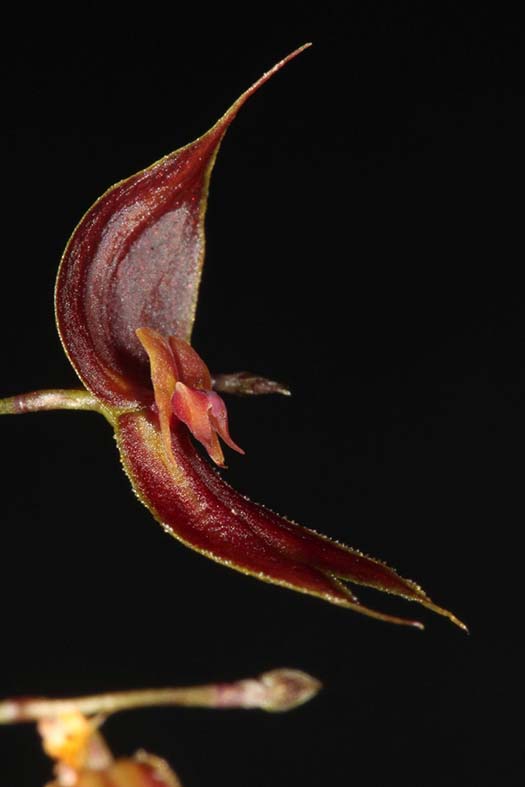
Lepanthes ophioglossaFound in Ecuador at elevations of 1500 to 2300 meters growing as a cool to cold growing epiphyte. Growing mounted to a small piece of tree fern with some sphagnum moss on the root. Hanging in a cool greenhouse. |
 |
 front cropped.jpg) |
 side cropped.jpg) |
Lepanthes spp.This unknown species was a gift from John Leathers. Is growing mounted to a piece of cork oak with some sphagnum moss on the roots. |
|
 front cropped.jpg) |
 side cropped.jpg) |
Masdevallia spp. (floribunda type)Masdevallia floribunda grows in Mexico, Guatemala, Belize, Honduras and Costa Rica at elevations of 400 to 1500 meters as a hot to cool growing epiphytic species. This orchid was a gift from Jeffrey Thompson and is growing outside mounted on a piece of wood with sphagnum moss on the roots. |
|
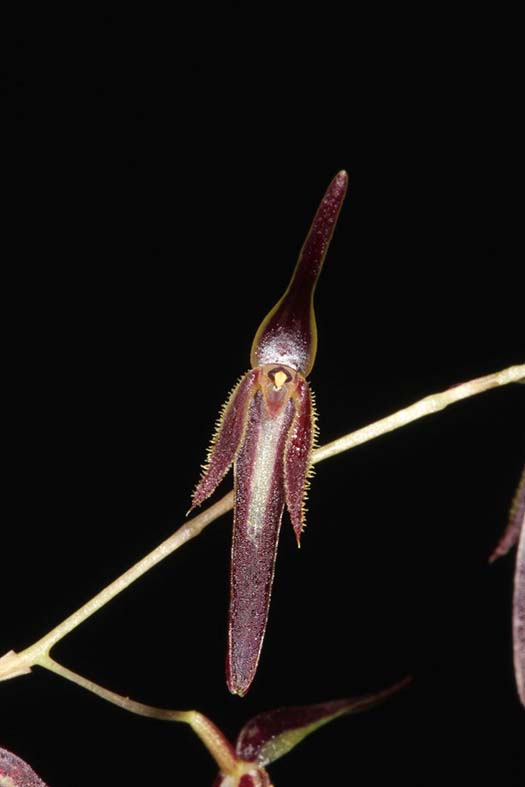 |
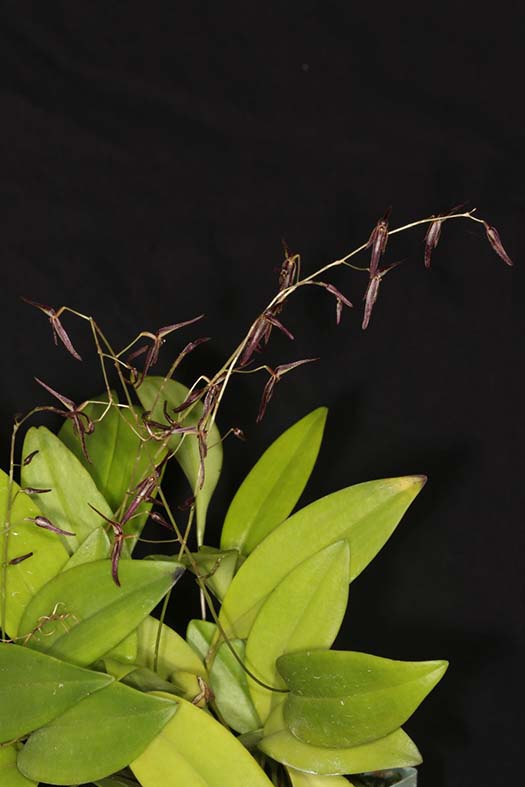 |
Pleurothallis strictaFound in Colombia and Ecuador at elevations between 1800 and 2500 meters. Is a cool to cold growing epiphyte. This orchid is growing in a plastic pot filled with sphagnum moss. Pot is in a cool greenhouse. |
|

Pleurothallis grobyi typeThis species is found in many countries including Mexico, Belize, Guatemala, El Salvador, Nicaragua, Costa Rica, Venezuela, Colombia, Ecuador, Peru, Brazil, French Guiana, Surinam, and Guyana. Is a hot to cold growing species found at elevations of 60 to 3200 meters. This mounted orchid is in a cool greenhouse. |
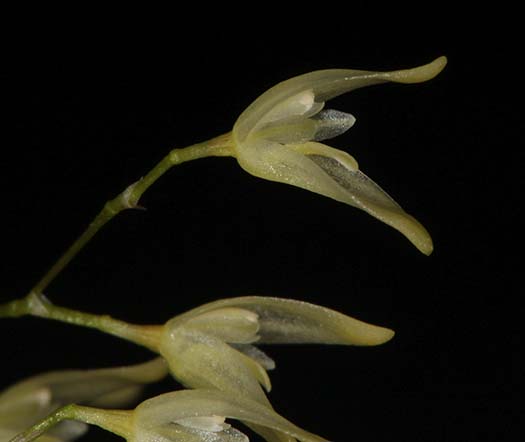 |

Pleurothallis megalopsA cool growing epiphyte found in Ecuador at about 1600 meters in elevation. This orchid is growing on a piece of wood with sphagnum moss on the root. This mounted orchid is in a cool greenhouse. |
 |
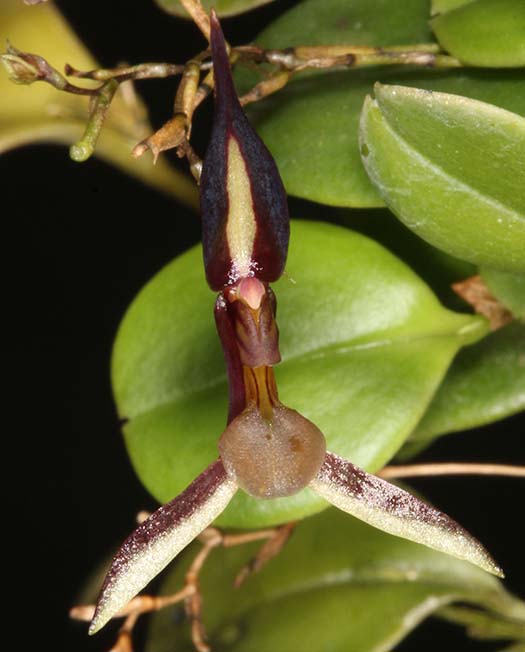
Pleurothallis mystaxFound in Panama at elevations of 650 to 1000 meters. In orchidspecies.com it is considered a hot growing epiphyte, but this orchid is growing well in a cool growing greenhouse. |
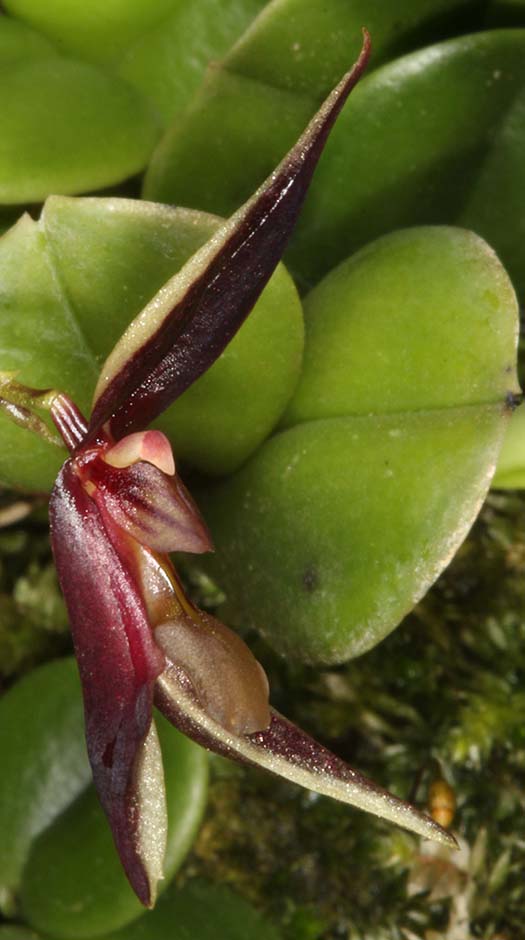 |
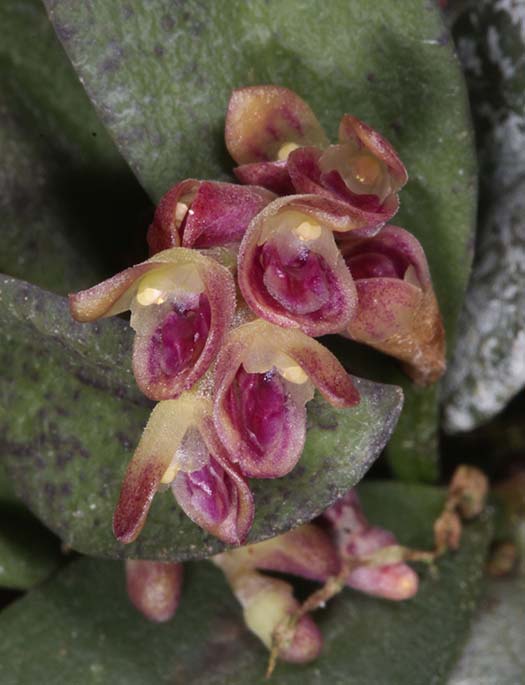
Pleurothallis recurvaA warm to cool growing creeping epiphyte found at elevations of 600 to 1400 meters in Ecuador, Peru, Bolivia and Brazil. This orchid is mounted a cork oak and is hanging in a cool greenhouse. |
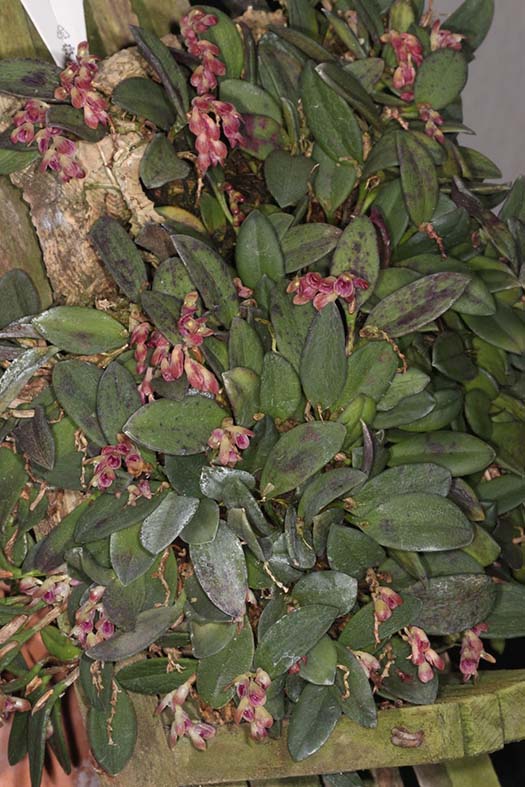 |
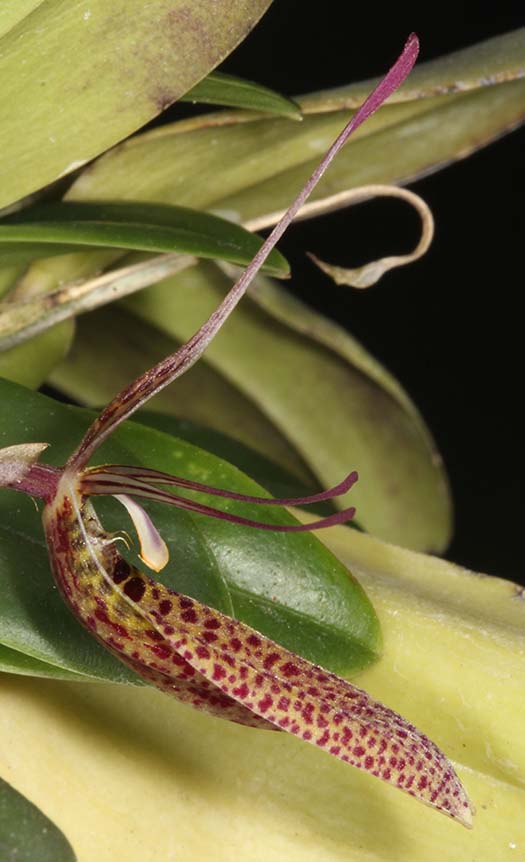
Restrepia sanguinea 'Ecuagenera'This cool to cold growing species is found in Colombia at elevations of 1500 to 2800 meters. This orchid is growing in a clay pot filled with sphagnum moss. The pot is in a cool greenhouse. |
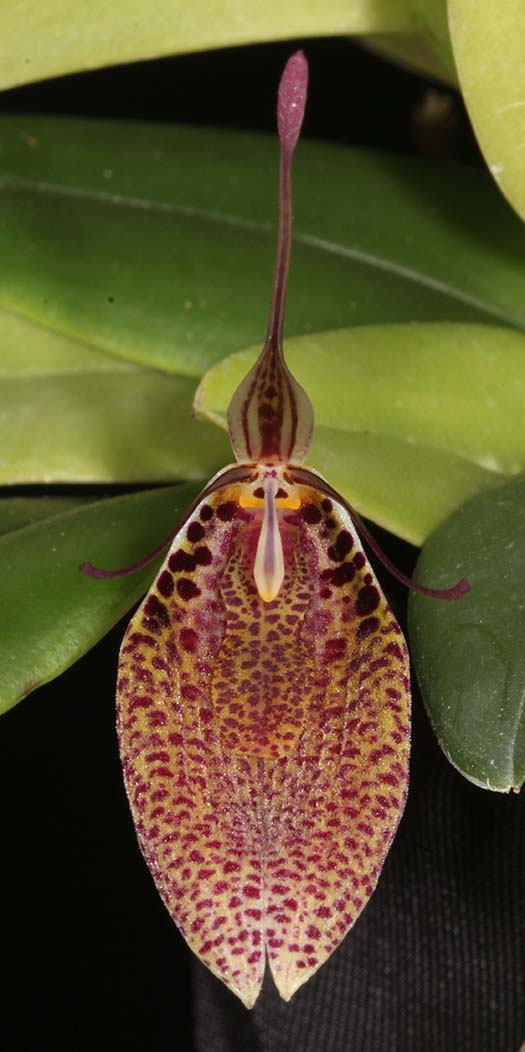 |
From Scott McGregor:All orchids grown outdoors, coastal southern California |
|
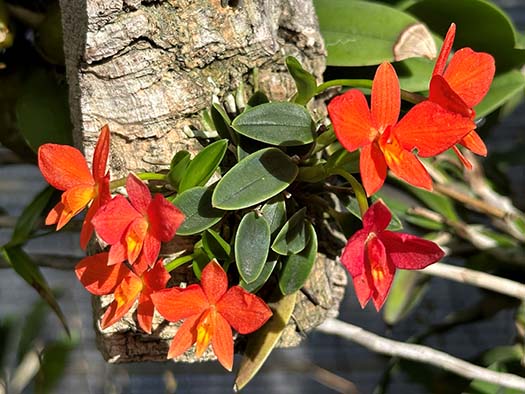 Cattleya (Sophronitis) pygmaeaOne of the smallest of the “Sophronitis” clan with flowers up to 1” in size, I find this grows best outdoors mounted and bright.
|
|
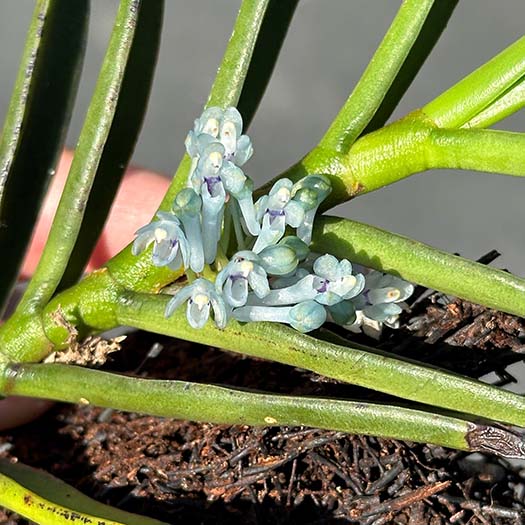
Cleisocentron gokusingiiOne of the better “blue” orchids. This plant flourished for me for more than ten years, with a dozen growths. Last year it started to lose leaves from the bottom and whole growths died back without an obvious cause. The plant almost completely crashed—I remounted it onto fresh tree-fern and managed to save two growths, one of which is now flowering, but the plant still isn’t very happy. I know Roberta had a similar problem with hers. Anyone familiar with “Cleisocentron crash”, what causes it and the prevention if not cure? I have two other species of Cleisocentron that seem to be happy, so far. |
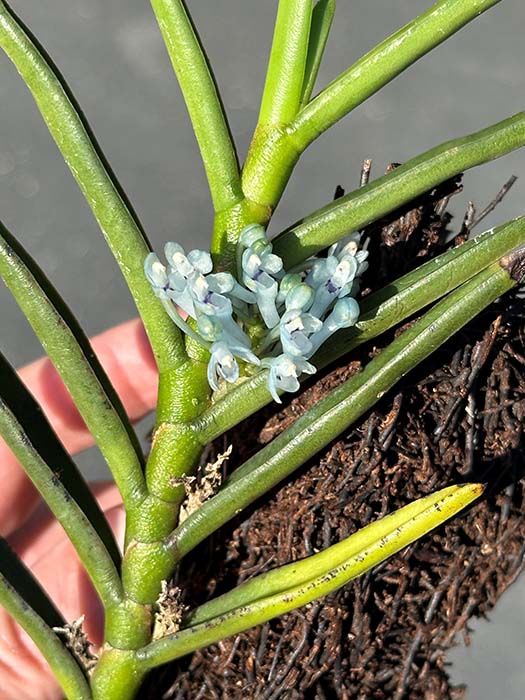 |

Oerstedella (Epidendrum) schweinfurthianumThis is a fabulous species—it takes a while to get to blooming size and needs bright light or preferably, full sun, but it sure puts on a show! You get months of intensely saturated red/orange and magenta flowers, at the tops of mature 3-5’ tall canes. It stays compact at the base, although gets big and bushy, so best on a patio or area where space isn’t constrained. |
|
Pleurothallis sarracenia gone to seed!The first pic is of my “kissing slugs” or “pitcher plant” Pleurothallis in bloom last July. Well, every single one of those flowers turned into a seed pod (second pic, close-up). I’m going to cut almost all of them off—let me know if you want me to save one for you to flask. Must either self easily or there’s a pollinator about! |
|
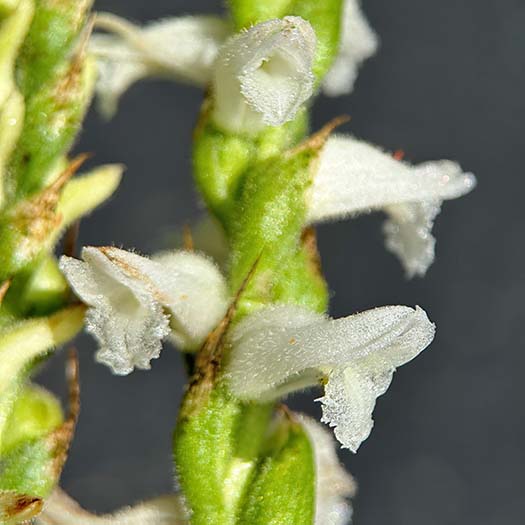
Spiranthes odorata 'Chadd's Ford'A damp-loving terrestrial that is endemic to the Southeastern US. Flowers aren’t much close up, but the blooming spikes are graceful, and it has a light, sweet scent. This species self-pollinates and sprouts everywhere it can find moist substrates. |
 |
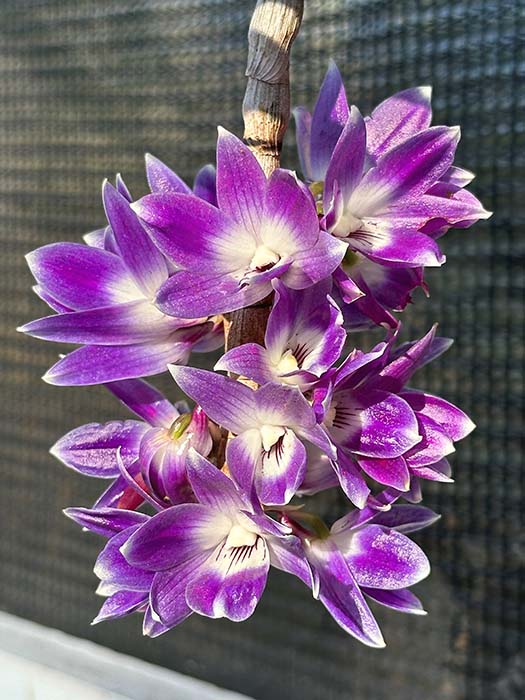
Dendrobium victoria-reginaeBlooming a second time this year—this is one of three canes in bloom. |
|
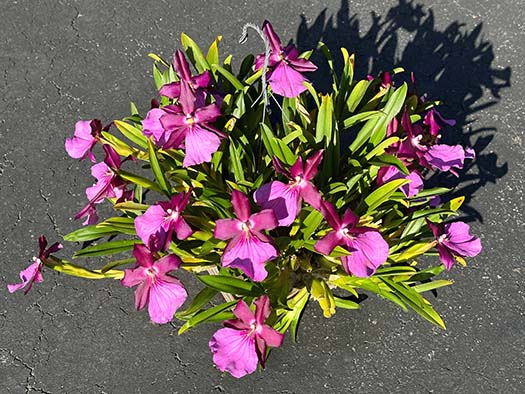
Miltonia morelianaThis is a fantastic species—large (4-5”) and long-lasting, licorice-scented flowers, and a reliable autumn bloomer. Best grown in baskets to avoid repotting. |
|
From Roberta Fox:Coastal southern California |
|
Outside in the Back Yard: |
|
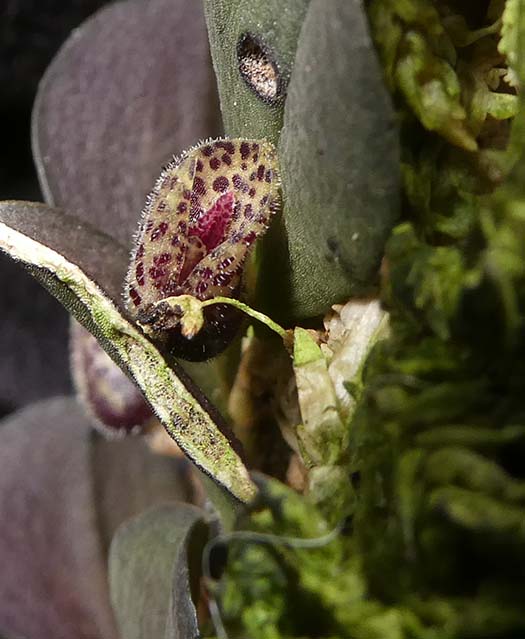 Acianthera hystrix
|
|
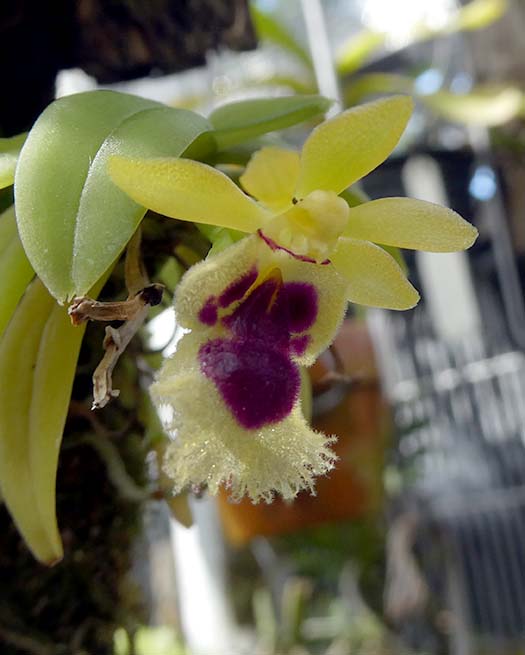
Haraella retrocalla (Gastrochilus retrocallus)Native to Taiwan. This miniature plant can grow either cool or warm, so it lends itself to terrarium growing as well as outside. The inflorescences tend to produce several flowers sequentially, and with a lovely fragrance. |
|
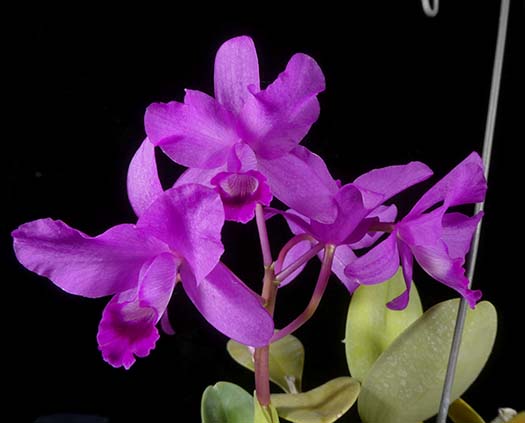
Guarianthe (Cattleya) bowringianaLast month I showed the coerulea form, this is the typical color form. |
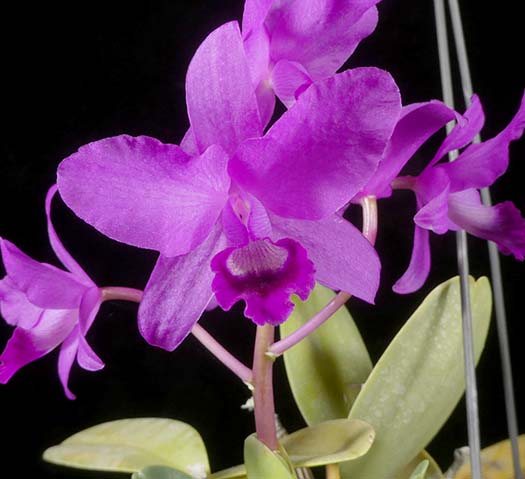 |
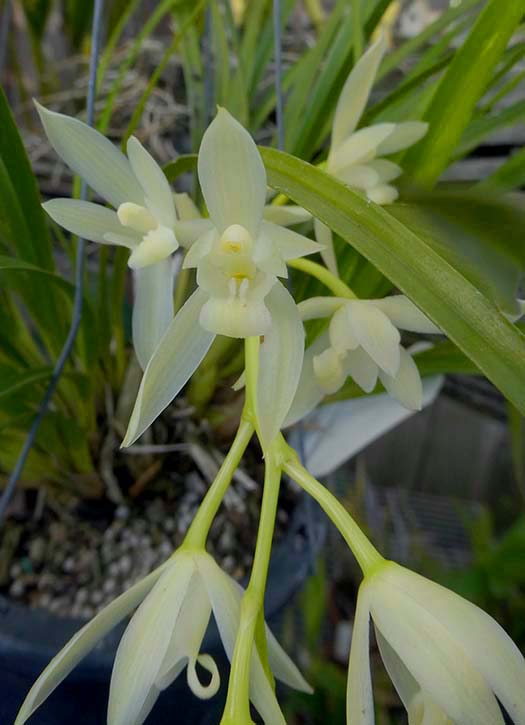
Cymbidium dayanum f. albumOne of the early-season Cymbidiums. This is the relatively unusual alba form. |
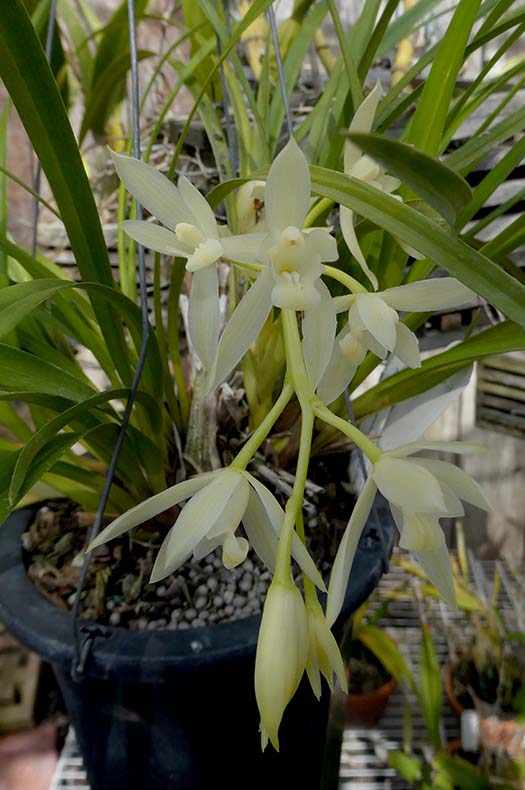 |

Dendrobium hekouenseA charming miniature with flowers bigger than the plant. Native to Yunnan, China. It goes completely deciduous in winter. I don't particularly dry it out, and that doesn't seem to matter. It does like the winter chill. |
|
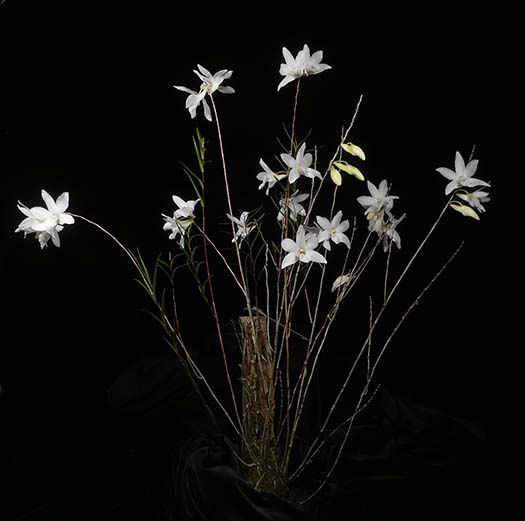 |
|
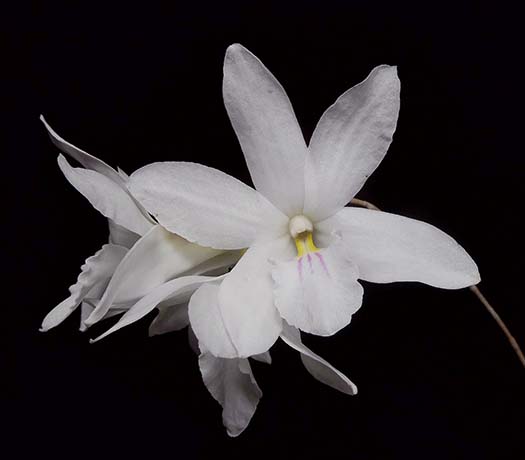 |
|
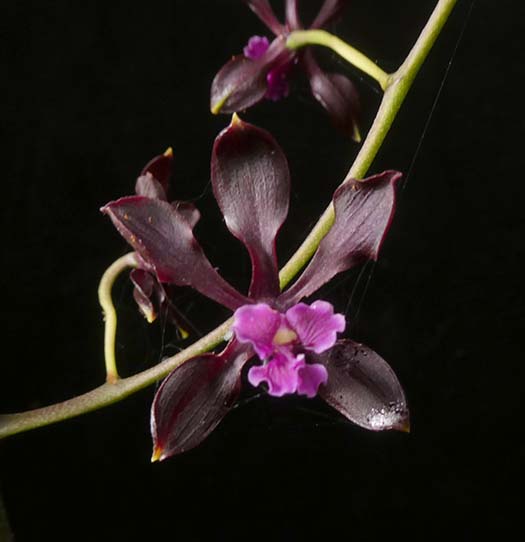
Encyclia atrorubensSpike is about 40 inches, flowers open very gradually. Segments are very dark purple, a nice contrast with the magenta-purple lip. Native to southwestern Mexico. |
|
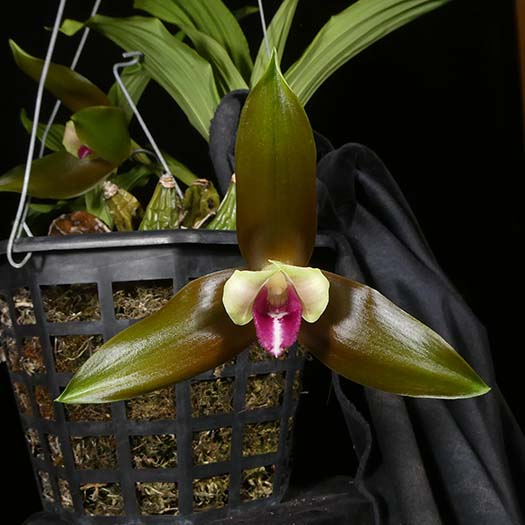
Lycaste schillerianaDramatic color contrasts. From Colombia and Panama. |
|
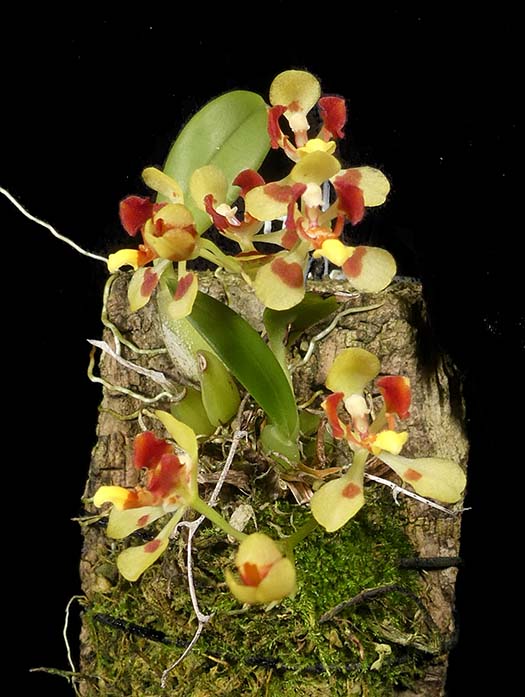
Gomesa colorata (Oncidium coloratum)Miniature plant with almost 1 inch flowers. As you can see, the amount of red on the lateral sepals is quite variable. Native to southeast Brazil |
|
 tipo 1.jpg)
Cattleya bicalhoi (Laelia dayana)The typical color form above, and coerula right. The strongly colored callus and striations in the throat show even the most directionally-challenged insect pollinator where they should go. Native to southeastern Brazil. |
 coerulea 1.jpg) |
 Miltonia moreliana 'Candella's Delight' AM/AOSNice form, big flowers on this cultivar. Compare with the "generic" Milt. moreliana below.
|
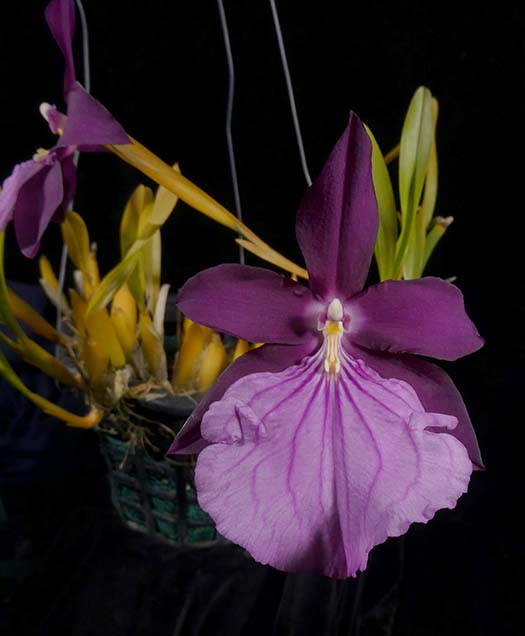 |

Miltonia morelianaFormerly Milt. specabilis var. moreliana, now a separate species. This one doesn't have the size or big, broad lip of the awarded cultivar, but it has deeper color and is much more floriferous. I love them both. Native to Brazil. |
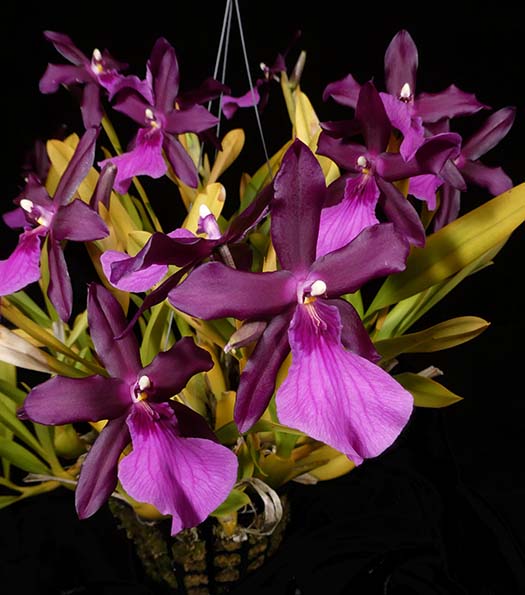 |
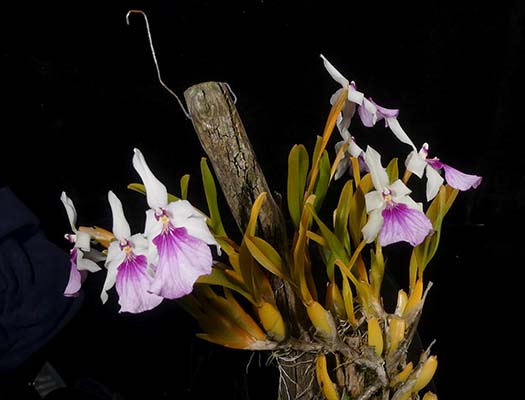 Miltonia spectabilis f. bicolorA close relative of Milt. moreliana |
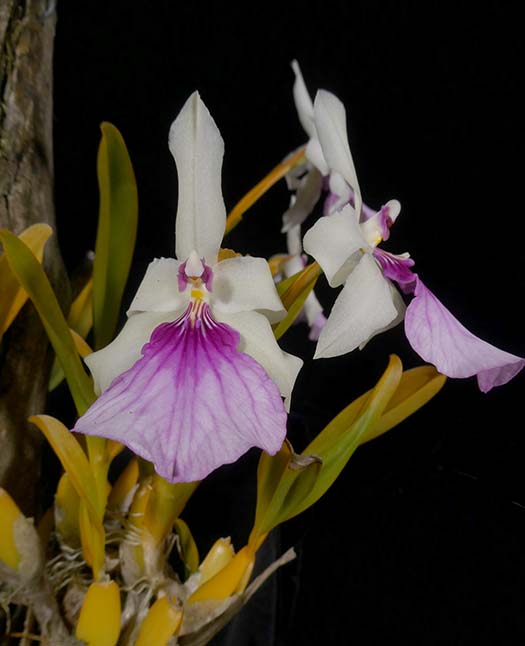 |

Prosthechea cochleataThe "cockle shell" or "octopus" orchid. This is just the start of the bloom. It will continue to produce new flowers at the tip of the inflorescences as the old flowers fade, and do it for about 6 months. By next March, the spikes will be 3 feet tall or more. It grows in Mexico, through Central America, into Venezuela. I have another cultivar of the same species that starts blooming in late spring, about the time that this one finishes. So with plants on different schedules, this species is almost a constant. |
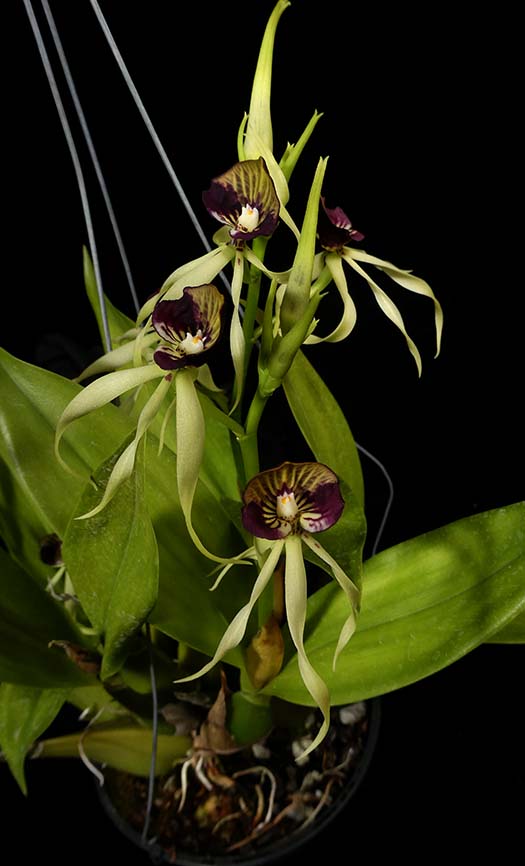 |
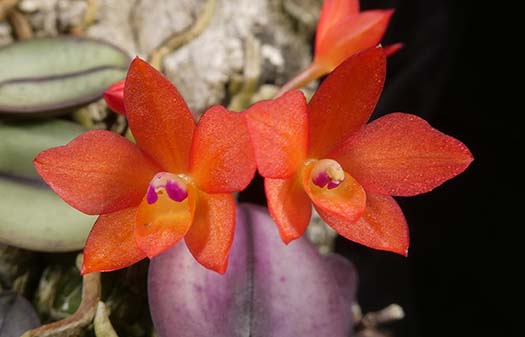 Cattleya (Sophronitis) cernuaOne of the smallest-flowered Sophronitis (about 1/2 inch flowers) but lots of them. This plant is particularly vigorous, with roots covering the mount in all directions. Flowers are crystalline, glistening in the sun. Native to Brazil. |
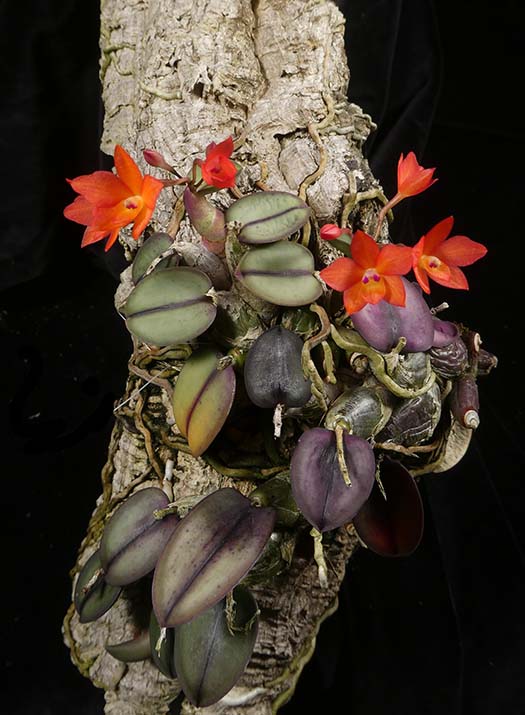 |
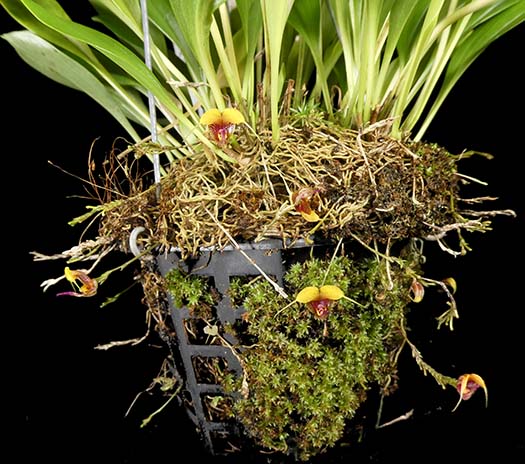 Scaphosepalum swertifolium ssp. exiguumLots of small, intricate flowers. It blooms sequentially on each inflorescence for many months, so old spikes don't get removed until they turn brown and brittle and just break off. From Ecuador, Colombia, and Peru. |
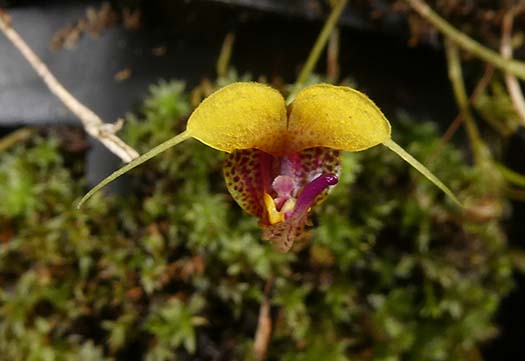 |
 |
|
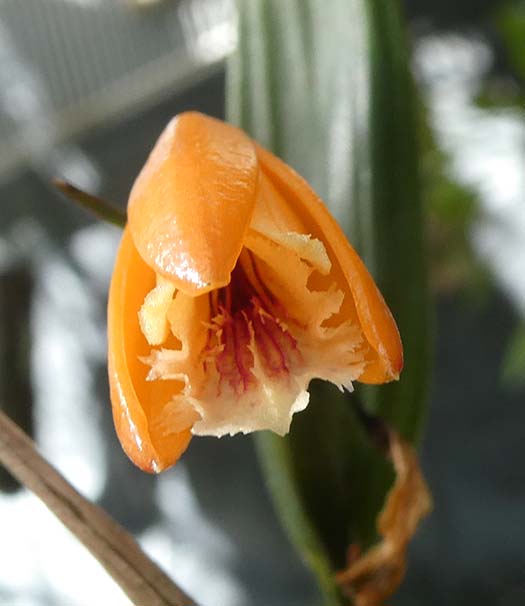
Sobralia croceaFlowers are only about 3/4 inch from back to front, and don't open fully, nodding downward. That makes them a challenge to photograph, but the detail is quite beautiful. Native to Ecuador and Peru. |
|
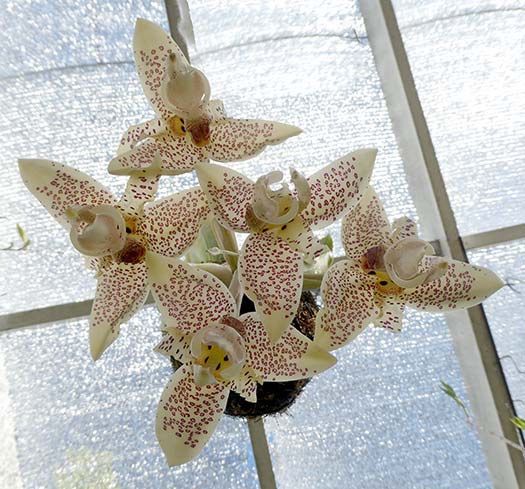 |
|
Stanhopea wardii 'Los Vientos Encinitas'This is a particularly vigorous cultivar. The cultivar name didn't mean a lot to me until one year it bloomed as the Santa Ana winds howled. (It reliably blooms in October, when those winds often occur.) I think that it originated with Bob Marlin, who lived in Encintas, though I acquired it from Jan Hennessey, for whom it also grew vigorously and produced multiple divisions. |
|
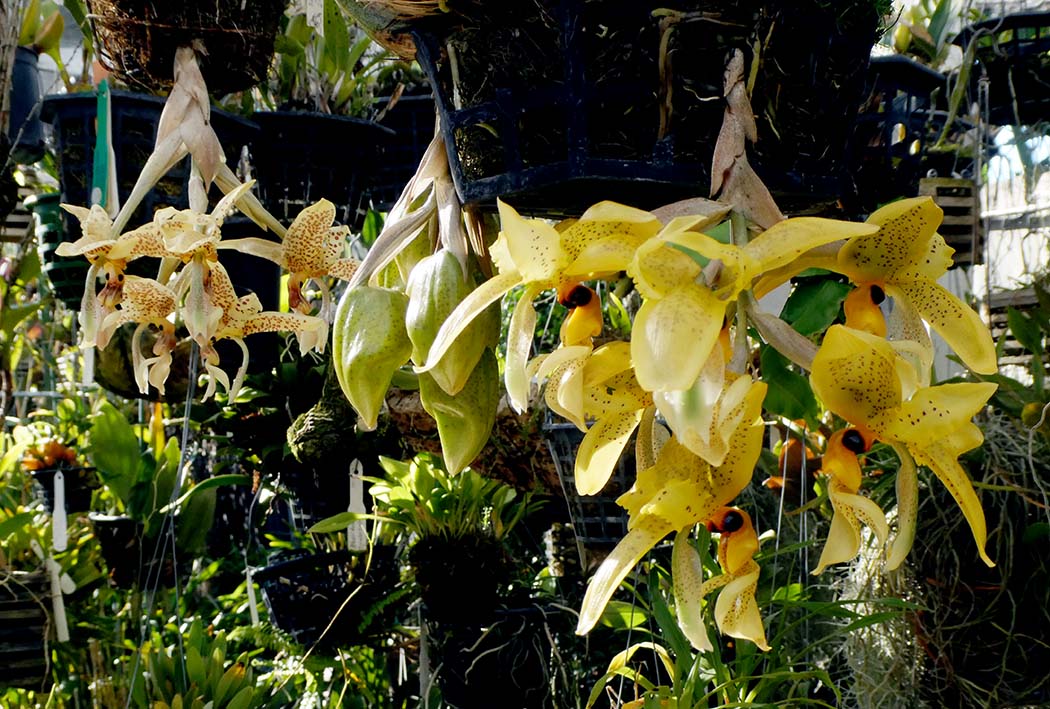 |
|
Stanhopea oculata and wardii blooming at the same time |
|
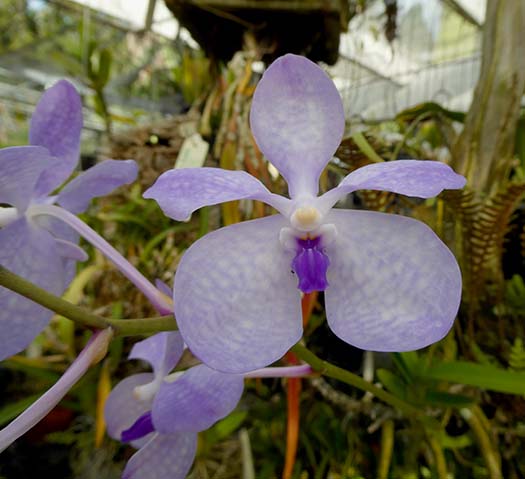 |
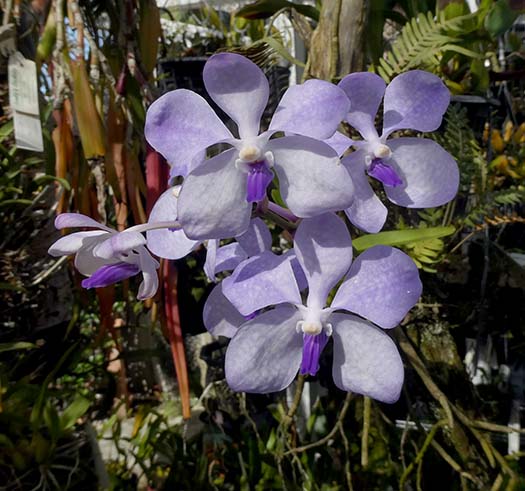 |
Vanda coeruleaI thought that I had lost this one when it dropped leaves and the crown looked dead. But it had a really good root system, so I left it in place, hoping for new growth. It tried once or twice, with new keikis not quite making it. Then, early this spring it started a new growth in earnest, which is now growing well, And got this lovely bloomng. This cultivar has enough white behind the violet tesselations to almost glow in the sun. Don't give up while there are signs of life! |
|
 |
|
Scaphosepalum gibberosumThe flowers of this species are among the largest in the genus, about 3 inches from tip to tip. It blooms successivesly on an inflorescence, and the plant has several inflorescences. It tends to do one flower at a time, two at most. If I get a flush bloom I'd be delighted, but I'm also satisfied with the onsie-twosies over months or even several years. |
|
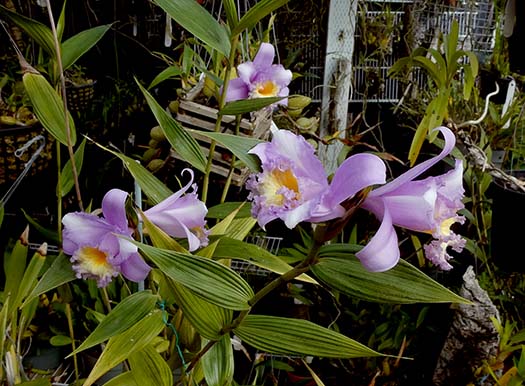 |
|
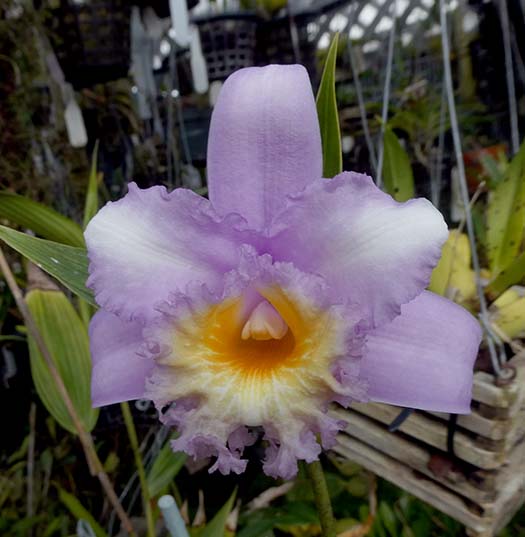 |
|
 |
 |
Zygopetalum maxillareNative to Paraguay and southern Brazil. The plant is smaller than the more common Zygopetalums. It grows in a basket, shady and damp. |
|
In the greenhouse... |
|
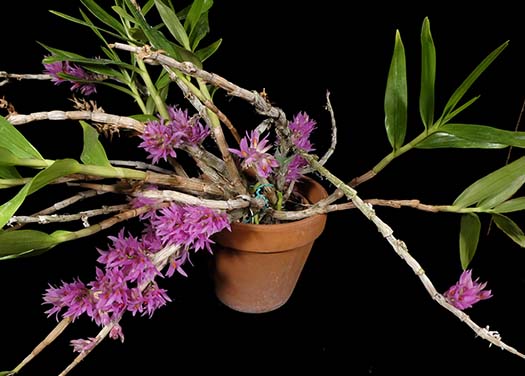 Dendrobium bracteosumFrom New Guinea and surrounding islands. This is a nearly non-stop bloomer. Flowers last for months, and as they inevitably eventually fade, new batches emerge. Flowers mostly emerge from old, leafless canes, and do so repeatedly, from canes that appear quite dead but clearly aren't. |
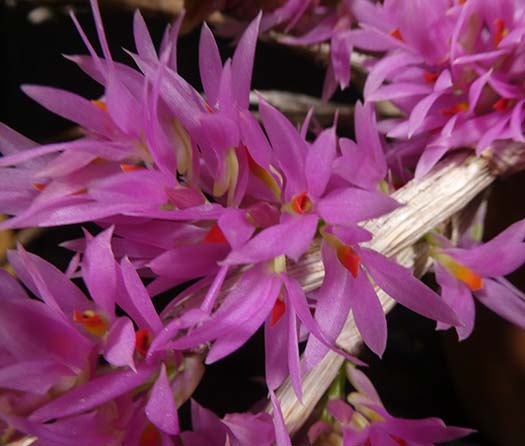 |
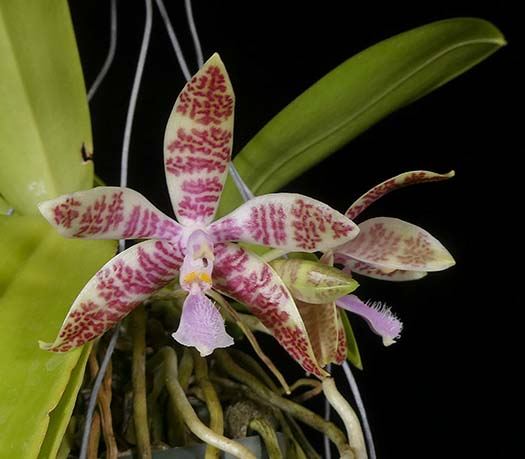 |
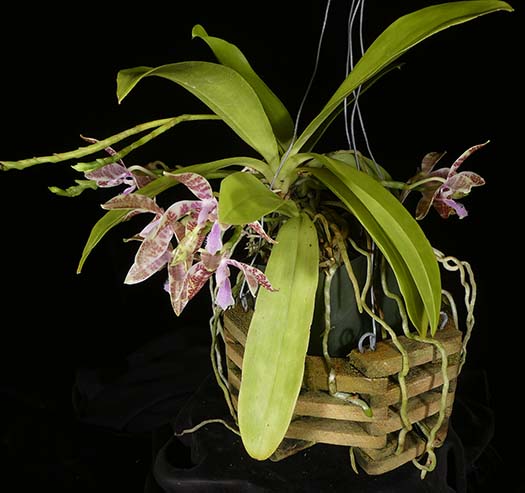 |
Phalaenopsis hieroglyphicaMost of the roots have escaped from the pot in the middle of the plant, and wrapped themselves around the wood basket. Spikes bloom repeatedly, and as the plant matures, it continues to produce more spikes, for a great floral display. |
|
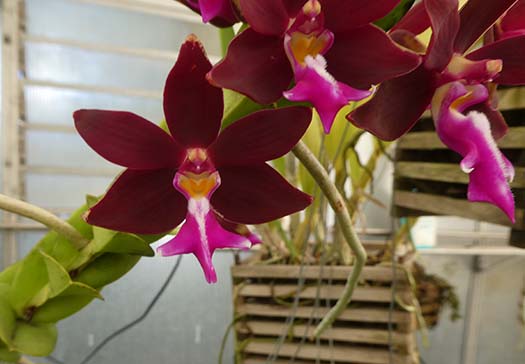
Trichoglottis atropurpureaThis is one of the relatively few orchids that propagates easiliy from cuttings. When I received it, I tied it to a slap of hapu'u which I placed in a pot, and put a few of the aerial roots down into the pot with coarse medium. Eventually, it produced more aerial roots, and side branches. I have tied it to the structure of the greenhouse to prevent it from tipping over, and exert a bit of control over its rambling habit. Dramatic flowers last for about 2 months. |
 |
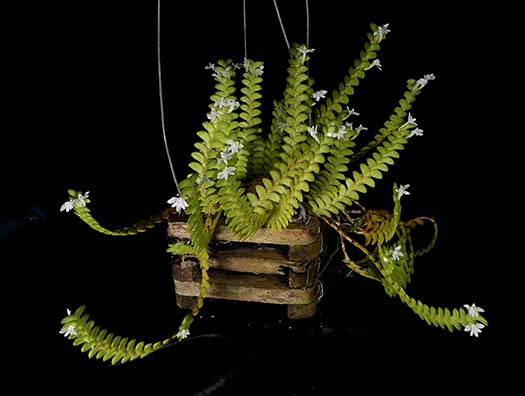 |
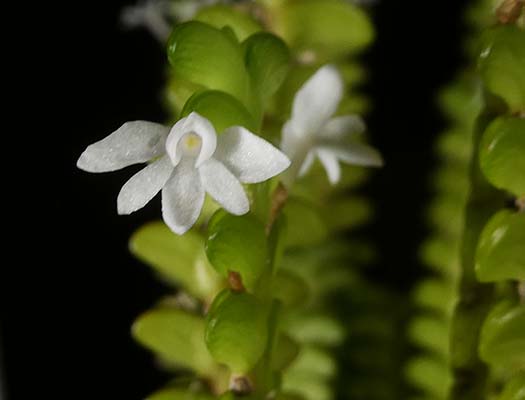 |
Angraecum distichumThis compact plant produces several flush blooms a year, as well as smaller blooms in between. Flowers are only about 1/4 inch. The plant produces new growths freely, but stays within the confines of a 4 inch basket. It is native to a wide area of central and western Africa, at elevations 200 m or lower. |
|
